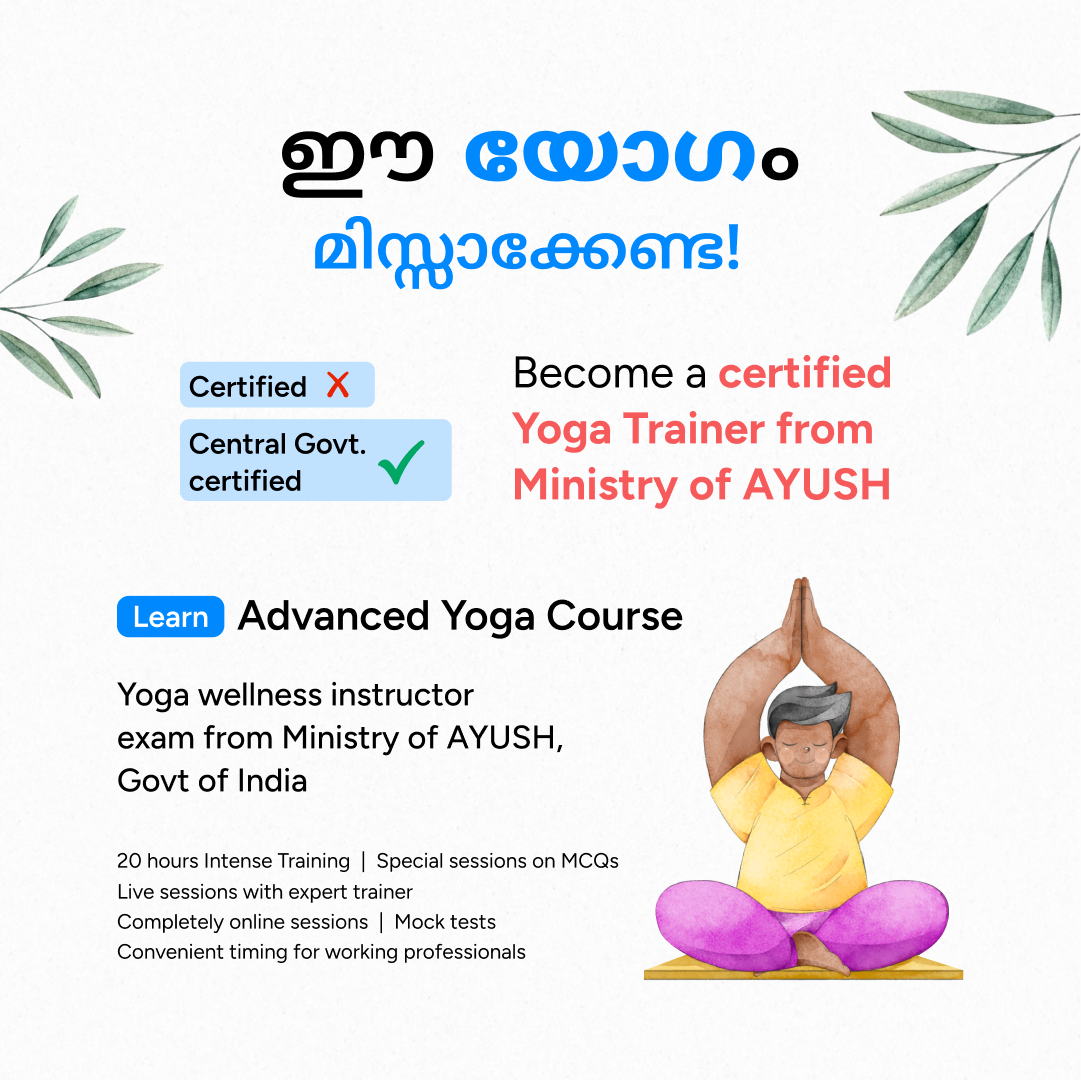Table of Contents
Having a healthy body and mind is crucial in the fast-paced world we live in today. Yoga is a popular tool used by many people to find inner peace and manage stress in their lives. One such powerful form of yoga is kriya yoga, which uses a variety of breathing exercises and asanas to assist practitioners reach a profound state of spiritual awareness. In this blog post, we will discuss how to practise Kriya Yoga.
Your Journey to a Fulfilling Yoga Career Starts Here! Get Free Demo Classes Here!
What is Kriya Yoga?
An ancient technique that aids in developing a deeper feeling of spiritual awareness is kriya yoga. One can achieve a deep level of meditative consciousness with the aid of this yoga method. Kriya yoga, which combines deliberate breathing exercises called pranayama with physical postures called asanas, may be a very fulfilling experience for the body, mind, and spirit.
Kriya yoga, an old discipline, was lost until rediscovered by Lahiri Mahasaya, who learnt about it from his yoga instructor Mahavatar Babaji in 1861. Later on, Kriya Yoga gained international recognition because to Paramahansa Yogananda’s book “Autobiography of a Yogi.” Since then, Kriya Yoga has spread throughout the globe due to its capacity to yield spiritual understanding.
The term “Kriya” itself suggests a divine relationship between activity and divinity. Kriya yoga, which is based on the science of breath, improves various forms of spiritual practice. The Kriya yoga method represents a profound awareness of the mind-breath relationship. The mind influences the breath, and the breath is controlled by the mind.
Types of Kriya Yoga
1: Which of these is the primary goal of yoga practice?
There are six “Shat Kriyas” in kriya yoga. When carried out correctly, each of these “Shat Kriyas” offers a unique set of advantages in addition to distinct approaches. Let’s have a quick talk about these.
Neti – This means clearing any pollutants from the nasal passages. Wax thread, milk, water, and a neti pot can all be used to do this. Maintaining regular nasal passage cleaning facilitates the easy flow of essential energy.
Dhauti – This Sanskrit term means “to wash,” meaning to take out pollutants that have become lodged in food or the windpipe. Through a specific procedure, contaminants like extra stomach mucous and other impurities are eliminated via vomiting.
Trataka – This is focussing on a stationary object, like a candle, for an extended period of time in order to increase your capacity for concentration.
Basti: This Kriya addresses health concerns pertaining to the stomach. One can aid in clearing the stomach of pollutants by engaging in physical activities and yoga asanas that are specifically targeted at the lower belly region.
Nauli: This method aids in enhancing the digestive system’s health. The intestines, spleen, and bladder are among the organs that benefit from the horizontal and vertical movements for improved digestion.
Kapalbhati: This Kriya pranayama method that promotes lung and brain health uses short, fast breaths.
Benefits of Kriya Yoga
Regular practice of Kriya Yoga has its own advantages. After you become an expert Kriya yoga practitioner at home, you will experience the following advantages.
Improved concentration and focus
Kriya yoga’s Trataka meditation improves our capacity for concentration and focus. We can now confidently complete our everyday activities and make the best selections without second thought. Thus, a higher quality of life is produced.
Spiritual Development
Kriya Yoga, in contrast to conventional yoga, incorporates mudras, mantra chanting, postures, and meditation. When practiced correctly, these elements can result in spiritual awakening. Our being is connected to a heavenly power through the chanting of the mantra during the meditation portion. In turn, this promotes inner tranquilly.
Improved physical health
Kriya yoga incorporates a number of kriyas that keep our bodies in shape, including kapalbhati, nauli, neti, and basti.
Removal of Toxins
When the various Kriyas and asanas are practiced regularly, our bodies’ toxins and impurities are eliminated, resulting in an internal balance.
Emotional Resilience
Emotional stability is a prerequisite for both inner calm and physical and mental alignment. You are now able to make decisions with clarity and move through life with more confidence.
Become a Certified Yoga Instructor
Yoga Teacher Training Course by Entri App: Master authentic yoga techniques, earn certification, and build a successful career as a professional yoga instructor.
Join Now!How to Practise Kriya Yoga at home?
Before you begin your Kriya yoga practice at home, you must prepare your surroundings, as well as your mind and body, for spiritual exercise. We advise you to set up a cosy and tranquil area where you can practise Kriya yoga for this reason. This can be accomplished by turning down the lights, putting out a scented candle, and turning on some pensive music.
You must first get your body and mind ready for this yoga exercise. Pay attention to your breathing. You must inhale slowly and steadily. As you take a breath and release it, pay attention to the air entering and leaving your body. Take some time to unwind and de-stress while you gently but deliberately enter a profound state of meditation.
You can begin practicing the several yoga poses that make up Kriya yoga after some time. As you grow more flexible through consistent practice, work your way up to increasingly complex asanas starting with some of the most fundamental ones. Among the asanas, or poses, that are frequently performed in Kriya Yoga are:
- Pambu Asana (the Cobra posture)
- Amaranth Kokkusana ( the seated Crane pose)
- Kriya Vanakam Asana ( Salutation Pose)
- Meenasana ( the fish pose)
It will be necessary for you to proceed slowly and deliberately. As you move through the asanas, pay attention to your breath and become more conscious of your physical sensations. After completing the asanas in Kriya yoga, you can proceed to the meditation portion of the practice. It should be mentioned that for more significant and safe results, as a novice, you should only execute these poses under the supervision of a certified yoga instructor.
- Step 1: Take a comfortable seat on a mat or a small stool. Put yourself so that your knees are lower than your hips.
- Step 2: Place your hands in front of you to achieve the lotus position. You should have your fingers entwined. You might also put your hands in front of you as an alternative.
- Step 3: Sit up straight, keeping your spine straight and your back straight. Make an effort to de-stress your body and mind.
- phase 4: This phase entails concentrating on a single idea. All you have to do is close your eyes and concentrate on an imaginary spot, which may be in the middle of your forehead. You can also direct your attention to tangible things, like a candle flame that is lighted, or you can just stare at an object or a specific spot on the ground. The goal here is to achieve a deeply calm state of mind through meditation.
- Step5: At this point, relax your body to make yourself feel comfortable. Consider any serene or pleasant recollection that can make you pleased and ultimately aid in relaxation.
- Step 6: Hold this posture for approximately five minutes. As you consistently practise, extend the duration of this contemplative posture to roughly 20 minutes. Your immunity will grow as a result of this overtime, leading to a spiritual awakening.
Conclusion:
A higher level of spiritual awareness can be attained through practicing kriya yoga. The comprehensive, all-encompassing nature of this yoga approach is contributing to its growing popularity. We may connect our body and spirit to the divine power through the various asanas, mantra chanting, and meditation when they are done with the support of Shat Kriyas.
Your Journey to a Fulfilling Yoga Career Starts Here! Get Free Demo Classes Here!
Become a Certified Yoga Instructor
Yoga Teacher Training Course by Entri App: Master authentic yoga techniques, earn certification, and build a successful career as a professional yoga instructor.
Join Now!Frequently Asked Questions
What is the technique of Kriya Yoga?
Kriya is an extremely sophisticated pranayama method used in Raja Yoga. The delicate currents of life energy (prana) in the brain and spine are strengthened and revitalised by kriya.
How long does it take to practice Kriya Yoga?
Daily Kriya Yoga practice for fifteen minutes can have a profound impact on our emotional and physical well-being.
What are the three practices of Kriya Yoga?
- Tapas (TAH-pahs), or self-discipline.
- Svadhyaya (SVAHD-yah-yah), or self-study.
- Ishvara pranidhana (ISH-var-ah PRA-nah-dah-nah), or devotion to a higher power.
Can Kriya Yoga heal?
In general, kriya yoga practice aids in both physical and spiritual development.























